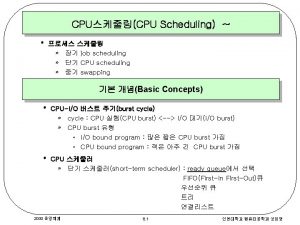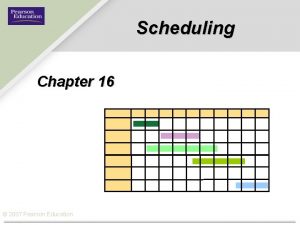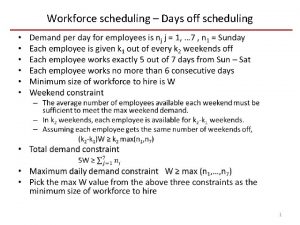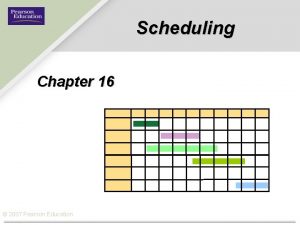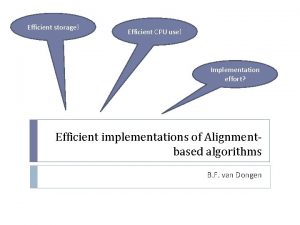An Efficient Centralized Scheduling Algorithm in IEEE 802








![System model and Problem solution Network Model [Uk, Qk] Uk =[Uk, f, t] Qk System model and Problem solution Network Model [Uk, Qk] Uk =[Uk, f, t] Qk](https://slidetodoc.com/presentation_image_h2/aa035f388693955712fbf5c838f4b8f4/image-9.jpg)
















- Slides: 25

An Efficient Centralized Scheduling Algorithm in IEEE 802. 15. 4 e TSCH Networks SPEAKER: YEI-REI CHEN ADVIDOR: DR. HO-TING WU DATE: 2017/04/20

Outline Introduction System model and Problem solution Throughput Simulation Reference Maximization scheduler and Result

Introduction TSCH scheduling Centralized : TASA Distributed : De. TAS

Introduction Bipartite graph

Introduction Complete Bipartite Graph

Introduction Maximum weighted bipartite matching(MWBM) G’ =( U’, V’, E’) be a weighted bipartite graph where U’ = {u’ 1, u’ 2, . . . , u’N}, V’= {v’ 1, v’ 2, . . . v’F} and E’ = {(u’, v’)|u’ ∈ U’, v’∈ V‘} A maximum weighted matching denoted by I* is to find a matching with the maximum total weight.

Introduction Hungarian alogorithm

System model and Problem solution Network Model Directed graph G = (V, E, d) V = {n 0, n 1, n 2, . . . , n. N} E is the set of links d consist of a set of physical distances , di, j Node communicateion randge Ri Directed link li, j
![System model and Problem solution Network Model Uk Qk Uk Uk f t Qk System model and Problem solution Network Model [Uk, Qk] Uk =[Uk, f, t] Qk](https://slidetodoc.com/presentation_image_h2/aa035f388693955712fbf5c838f4b8f4/image-9.jpg)
System model and Problem solution Network Model [Uk, Qk] Uk =[Uk, f, t] Qk is the number of packets in the buffer of nk Ck, f, t as the channel capacity of link lk, f at time t.

System model and Problem solution Network Model Uk, f, t is defined as the maximum number of packets that can be transmitted over lk, f at time t. Uk, f, t T is the slot frame duration

System model and Problem solution Network Mk, f, t Model is defined as effective rate of link lk, f, t

System model and Problem solution Network Model

System model and Problem solution Interference GI Model =( VI, EI). Interference occurs when a node have more than one communication in a single time slot transmitting and receiving at the same time receiving from multiple nodes

System model and Problem solution Interference Model Consider node ni, the transmission of node nj will interfere with the transmission of ni if

System model and Problem solution Throughput Maximization Problem Combinatorial optimization problem Solved by graph-based theoretical algotithm in polynomial time Graph-base theoretical based on matching theory such that problem transformed to another MWBM problem

System model and Problem solution Throughput Maximization Problem

System model and Problem solution Throughput Maximization Problem Π be the maximization problem formulation and z ≥ 1. A feasible solution s of an instance I of Π is a z objective optimal OΠ(s) function value OΠ(s) objective function value OΠ’(I) ≥ (OΠ’(I)/z).

System model and Problem solution Throughput Maximization Problem

System model and Problem solution Throughput Maximization Problem Π’ be the optimization problem obtained from Π by substitutin X of Π can be converted to a solution of Y of Π’ with OΠ’(Y )=OΠ(X) in polynomial time

System model and Problem solution Throughput Maximization Problem

Throughput Maximization scheduler

Simulation and Result Deployment : randomly deployed in a square area of 200 m*200 m Slot : 15 ms Slotframe : 50 slots equal to 0. 75 s Simulation total time : 3000 slotframes equal to 37. 5 min Number of nodes : 10 to 100

Simulation and Result

Simulation and Result

Reference Mike Ojo, Stefano Giordano, ” An Efficient Centralized Scheduling Algorithm in IEEE 802. 15. 4 e TSCH Networks”, Conference on Standards for Coummunications and Networking(CSCN)
 Bridges from 802.x to 802.y
Bridges from 802.x to 802.y Bridges from 802.x to 802.y
Bridges from 802.x to 802.y Ieee 802 3 compliance
Ieee 802 3 compliance Ieee802.22
Ieee802.22 Arquitetura ieee 802
Arquitetura ieee 802 Ieee 802 que es
Ieee 802 que es Ieee 802 standard
Ieee 802 standard Ieee 802 bluetooth
Ieee 802 bluetooth 802 ieee
802 ieee Ieee 802
Ieee 802 Ieee 802 family
Ieee 802 family Productively efficient vs allocatively efficient
Productively efficient vs allocatively efficient Productively efficient vs allocatively efficient
Productively efficient vs allocatively efficient Productive inefficiency and allocative inefficiency
Productive inefficiency and allocative inefficiency Productively efficient vs allocatively efficient
Productively efficient vs allocatively efficient Productively efficient vs allocatively efficient
Productively efficient vs allocatively efficient Efficient cab scheduling
Efficient cab scheduling Job scheduling vs process scheduling
Job scheduling vs process scheduling Cure: an efficient clustering algorithm for large databases
Cure: an efficient clustering algorithm for large databases Efficient variants of the icp algorithm
Efficient variants of the icp algorithm Efficient variants of the icp algorithm
Efficient variants of the icp algorithm Elevator scheduling algorithm
Elevator scheduling algorithm Preeptive
Preeptive Windows process scheduling
Windows process scheduling Long term scheduler
Long term scheduler Greedy interval partitioning
Greedy interval partitioning


































